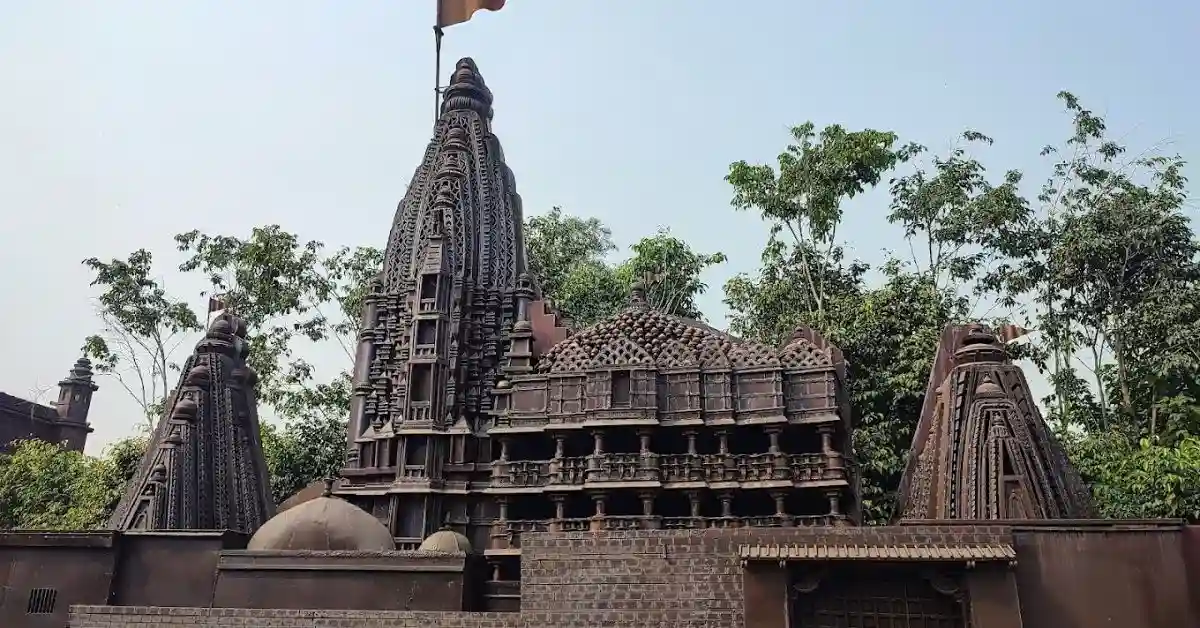About Jantar Mantar Delhi
Jantar Mantar Delhi is a remarkable astronomical observatory with immense historical and scientific significance. Its main purpose was to arrange astronomical tables and to predict the times and movements of the Sun, Moon and Planets. It is one of the five sites built by the Maharaja Jai Singh II of Jaipur. The biggest one is situated in Jaipur and the rest are in Ujjain, Varanasi and Mathura.
The complex comprises a collection of 13 architectural astronomy instruments which are used for measuring time, predicting celestial events and observing celestial bodies. Among its notable structures is the Samrat Yantra, a Colossal sundial that remains the largest of its kind globally, offering astonishingly accurate timekeeping. Other instruments include the Ram Yantra, Jai Prakash Yantra, Misra Yantra and more, each serving a specific astronomical function. Unfortunately, due to construction of tall buildings in its surroundings, it no longer provides the correct calculations.
Jantar Mantar still continues to captivate visitors with its historical significance and serves as a reminder of India’s rich scientific and cultural heritage. It is also recognised as a UNESCO World Heritage Site.
History & Architecture Of Jantar Mantar Delhi
Jantar Mantar Delhi boasts a rich history and fascinating architecture. It was constructed by Maharaja Jai Singh II of Jaipur in the early 18th century. The history of Jantar Mantar dates back to a time when astronomy played a crucial role in various aspects of life including agriculture, navigation and religious ceremonies.
The Mughal Emperor, Muhamad Shah commissioned Maharaja Jai Singh II to evaluate the astronomical calendars, charts and data to ensure accurate information about the movement of celestial bodies. Jai Singh wanted to analyse the ancient Islamic calendars for a deeper understanding of time as he also has the knowledge of astronomy.
To achieve this objective, Jai Singh built Jantar Mantar in 1724 and the observatory of Delhi was the first one to be built. Over time, other observatories were built in different locations including Jaipur, Ujjain, Varanasi and Mathura. The purpose behind constructing these observatories was to accurately predict the time and track the movement of Planets to gather the information about the celestial bodies for the benefit of both individuals and society as a whole.
The observatory consists of a series of large masonry instruments strategically placed within a vast open space. Each instrument serves a specific purpose, ranging from measuring time to predicting celestial events and tracking the movements of celestial bodies. The geometric precision of their design is awe-inspiring, showcasing the advanced mathematical and scientific knowledge of the time. The positioning of the instruments aligns with the cardinal directions and celestial phenomena, allowing for accurate observations and calculations.
Over the time, Jantar Mantar has undergone restoration efforts to preserve its historical and architectural integrity. Today, it stands as a UNESCO World Heritage site, attracting visitors from around the world who are captivated by its rich history and scientific significance. Exploring Jantar Mantar provides a unique opportunity to delve into the ancient world of astronomy and marvel at the architectural brilliance of this remarkable observatory.
Astronomical Instruments At Jantar Mantar Delhi
Jantar Mantar Delhi has 13 astronomical Instruments which reflect the remarkable astronomical knowlegde and precision of the astronomer of the past. Some of these are as follows:
- Samrat Yantra: The Samrat Yantra also known as the Supreme Instrument is a colossal triangular sundial. This remarkable instrument transformed the traditional sundial into a precision tool capable of measuring declination and related coordinates of celestial bodies. The Vrihat Samrat Yantra can calculate the local time with an accuracy of up to two seconds and is known as the largest sundial in the world.
- JayaPrakash Yantra: The JayaPrakash Yantra consists of hollow hemispheres with marked concave surfaces. Crosswires are stretched between points on the rim. Observers within the structure align the position of a star with the markings or the edge of a window. This versatile instrument enables the determination of celestial object coordinates in various systems, including the azimuthal-altitude system and the equatorial coordinate system, facilitating easy conversion between different celestial systems.
- Rama Yantra: It comprises two large cylindrical structures with open tops which are used to measure the altitude of stars based on latitude and longitude of Earth.
- Misra Yantra: The Misra Yantra means “mixed instrument” It combines five instruments to determine the shortest and longest days of the year. It has the ability to exactly determine the movement of noon in various cities, irrespective of their distance from Delhi. The Misra Yantra is the only instrument in the observatory which was not invented by Jai Singh II.
- Shasthansa Yantra: It is built within the towers supporting the quadrant scales and it utilises a pinhole camera mechanism. It helps to measure specific measurements of the sun like zenith distance, declination and diameter.
- Kapala Yantra: Kapala Yantra is Similar to the JayaPrakash Yantra, it demonstrates the transformation from one coordinate system to another. However, it is not actively used for celestial observation.
- Rasivalya Yantra: Rasivalya Yantra has twelve structures which represent the Zodiacal constellations. It measures the latitude and longitude of a celestial object at the moment it crosses the meridian and provides information about celestial objects in relation to the Zodiac.
Things To Do At Jantar Mantar Delhi
- Explore the fascinating collection of astronomical instruments and marvel at their intricate designs and historical significance.
- Learn about the functioning and purpose of each instrument through informative panels and knowledgeable guides.
- Observe the giant sundial, Samrat Yantra and witness its impressive accuracy in measuring time.
- Enjoy the panoramic views of the surrounding area from the observation platforms within the complex.
- Capture memorable photographs against the backdrop of the unique architectural structures.
- Attend informative presentations or guided tours to deepen your understanding of the astronomical principles behind Jantar Mantar.
- Immerse yourself in the historical and cultural heritage of India by visiting this UNESCO World Heritage site.
- Engage in educational activities and interactive exhibits to learn about the significance of astronomy in ancient times.
- Enjoy a leisurely stroll through the spacious grounds and appreciate the serene ambiance of the observatory.
- Take advantage of the open spaces to relax, meditate or engage in peaceful contemplation amidst the historic setting.
Jantar Mantar Delhi Tickets Price/Entry Fees
The Entry fees of Jantar Mantar of Delhi is Rs 15 for Students, Indian Resident, SAARC and BIMSTEC visitors. The tickets price of Jantar Mantar Delhi for Foreign Tourists is Rs 200. There are no charges for photography but Rs 25 must be paid for video filming.
| Category | Tickets Price |
|---|---|
| Entry Fees (Indians) | Rs 15 |
| Entry Fees (Foreign Tourists) | Rs 200 |
| Entry Fees (SAARC Visitors) | Rs 15 |
| Entry Fees (BIMSTEC Visitors) | Rs 15 |
| Photography | Free |
| Video Filming | Rs 25 |
Jantar Mantar Delhi Online Ticket Booking
The ticket of Jantar Mantar Delhi can be booked online through this website.
Jantar Mantar Delhi Timings
Jantar Mantar in Delhi is open all 7 days of the week from 6 AM to 6 PM. The opening time of Jantar Mantar of Delhi is 6 AM and its closing time is 6 PM.
Best Time To Visit Jantar Mantar Delhi
The best time to visit Jantar Mantar in Delhi is during winter season from October to March. The weather during this time is pleasant and comfortable for exploring the outdoor observatory. You can also visit Jantar Mantar during weekdays to avoid crowd as it is less crowded than weekends.
Jantar Mantar Delhi Images/Photos
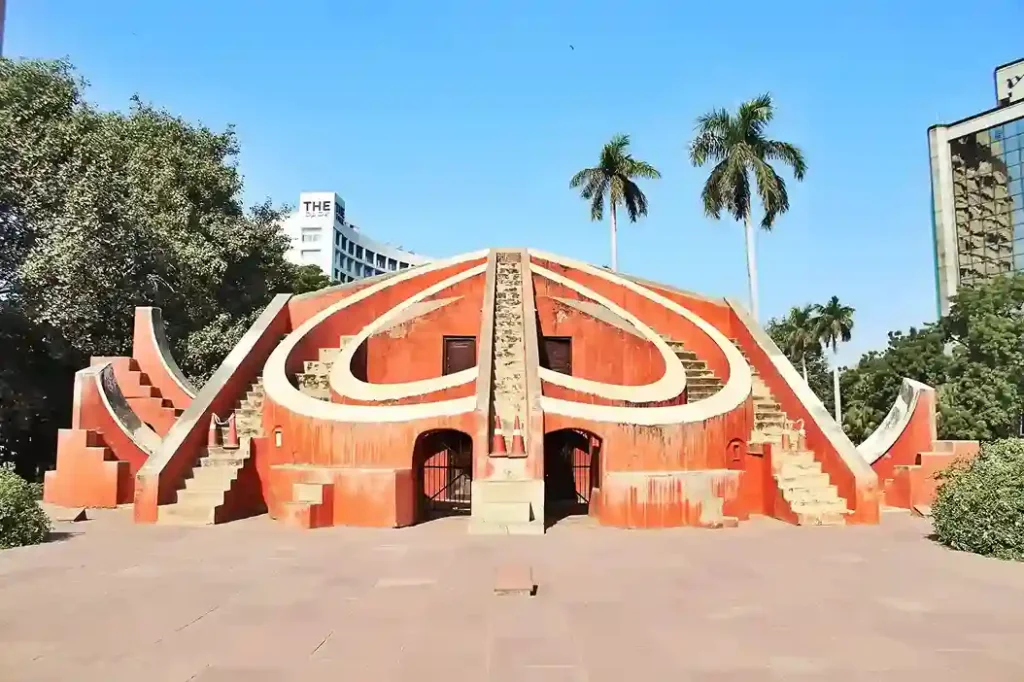
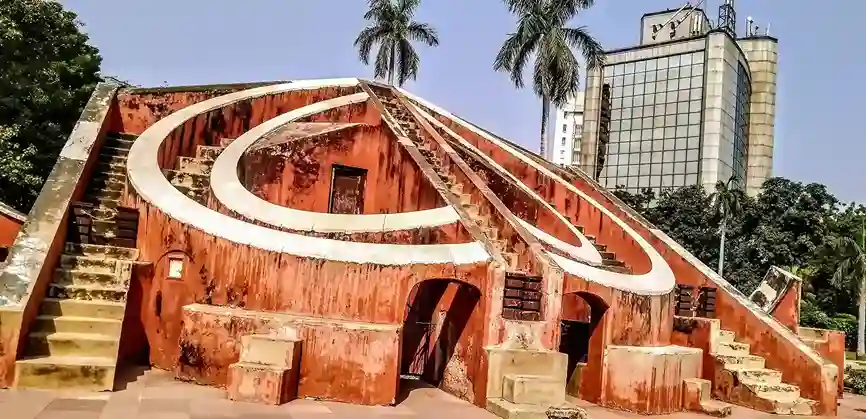
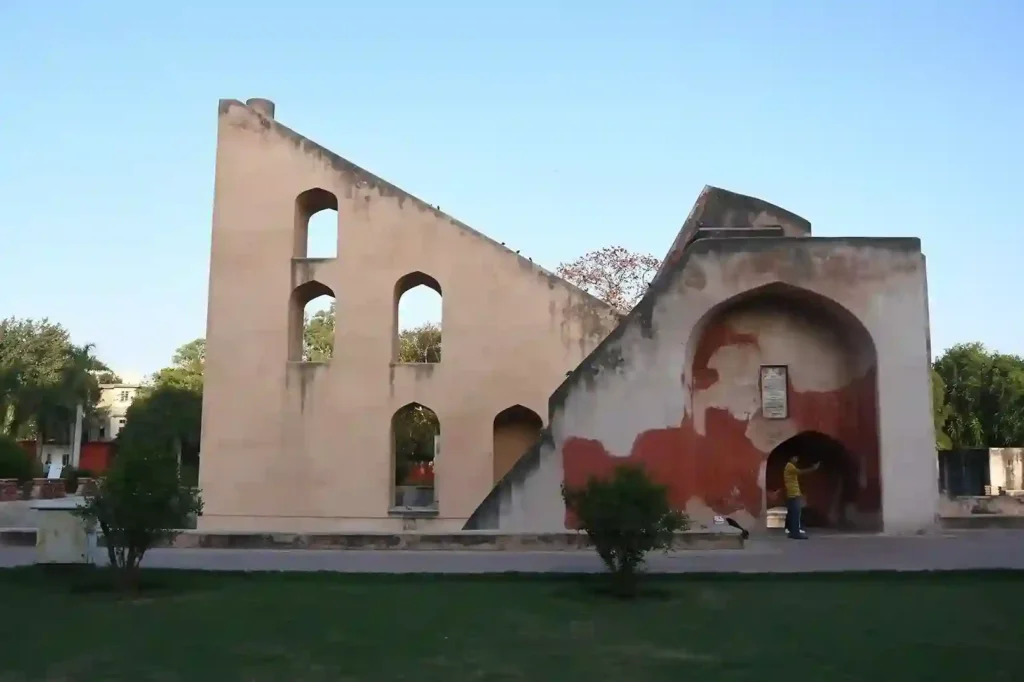
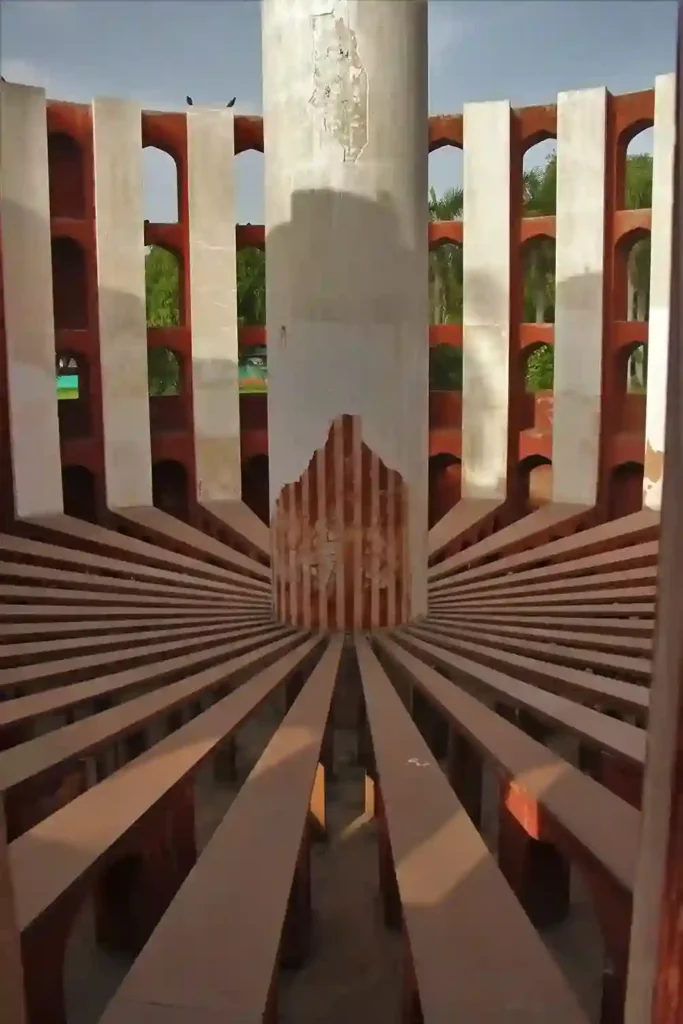
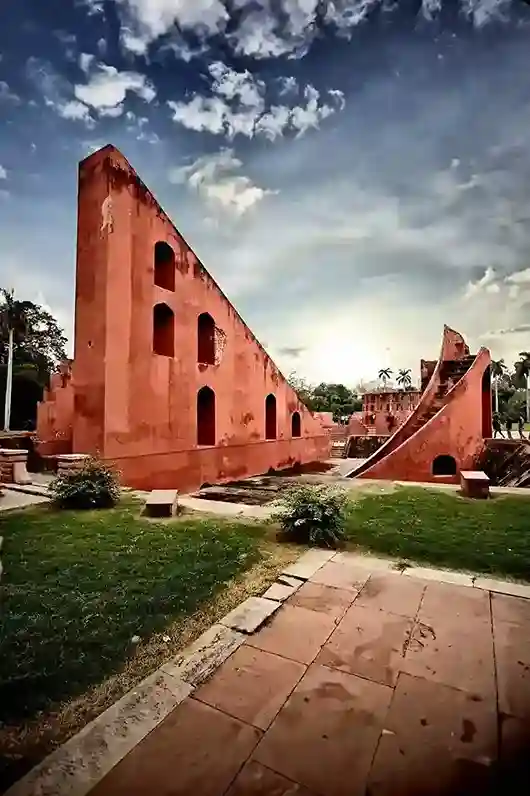
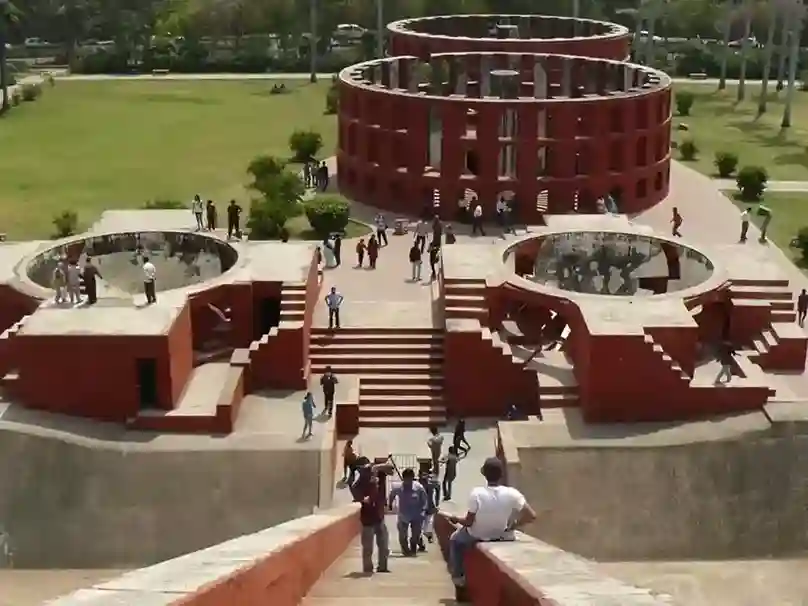
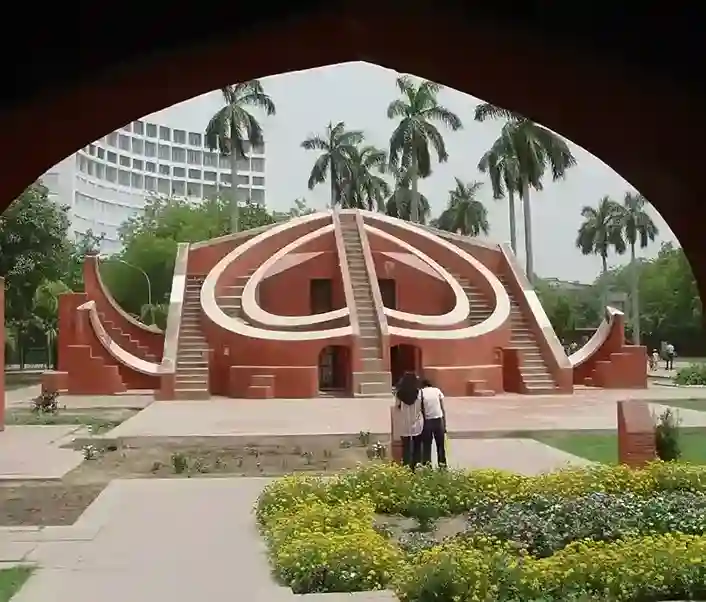
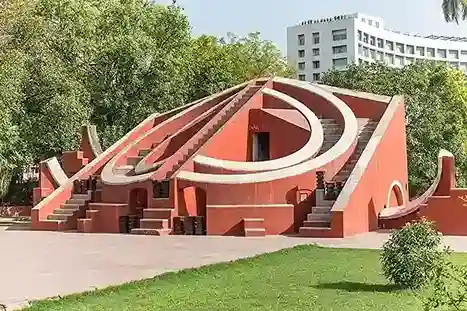
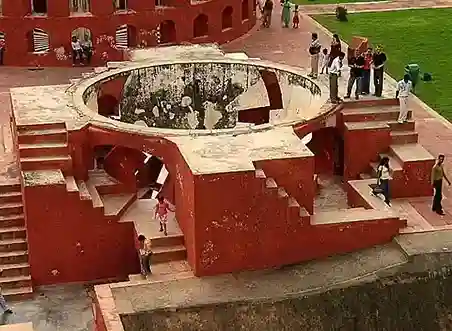
Facilities At Jantar Mantar Delhi
- Information Panel
- Guided Tours
- Restrooms
- Seating Area
Address Of Jantar Mantar Delhi
Jantar Mantar in Delhi is situated at Connaught Place, Sansad Marg, New Delhi, Delhi.
How To Reach Jantar Mantar Delhi
The Jantar Mantar is located near Connaught Place, Sansad Marg, New Delhi. It is easily accessible from all parts of the city. You can reach here by the following modes of the transport:
By Metro: The Nearest Metro Station to Jantar Mantar is Rajiv Chowk Metro Station (800 m) on Yellow line and Janpath Metro Station (650 m) on violet line. From there, you can take a rickshaw or book a cab to the monument or Walk to Jantar Mantar.
By Bus: The Nearest Bus Stop to Jantar Mantar is Jantar Mantar Bus Stop which is 280m away from the monument. You can reach the bus stop by Bus no. 378 and 390. From there, you can easily walk to the monument.
By Cab/Autorickshaw: You can easily book a cab/Autorickshaw to the Jantar Mantar.
By Personal Vehicle: You can easily come with your personal vehicle.
Parking Facility At Jantar Mantar Delhi
There is parking space available near the Jantar Mantar.
Website Of Jantar Mantar Delhi
The official website of Jantar Mantar is http://www.delhitourism.gov.in/
Contact Number Of Jantar Mantar Delhi
You can contact Jantar Mantar in Delhi at 011 2336 5358.
Places To Visit Near Jantar Mantar Delhi
Top attractions to visit near Jantar Mantar in Delhi:
- Janpath Market (350 m)
- Palika Bazaar (700 m)
- Museum of Illusions (750 m)
- Connaught Place (800 m)
- Pracheen Hanuman Mandir (800 m)
- National Philatelic Museum (800 m)
- Gurudwara Sri Bangla Sahib (1 Km)
- National Museum (2.1 Km)
- Shri Laxmi Narayan Temple (Birla Mandir) (2.3 Km)
- India Gate (2.7 Km)
- Rashtrapati Bhavan Museum (2.9 Km)
- National Gallery of Modern Art (3.3 Km)
- Nehru Planetarium (4 Km)
- Jama Masjid (4.3 Km)
- Khan Market (4.4 Km)
- Pradhanmantri Sangrahalaya (4.6 Km)
- Lodhi Garden (4.7 Km)
- National Science Centre (4.8 Km)
- Purana Qila (5.1 Km)
- Red Fort (5.1 Km)
- Shankar’s International Dolls Museum (5.2 Km)
- National Zoological Park (5.6 Km)
- Humayun’s Tomb (5.9 Km)
- Sunder Nursery (6.1 Km)
- National Rail Museum (7.3 Km)
- Nehru Park (7.5 Km)
People Also Read
- Worlds Of Wonder Noida
- Waste To Wonder Park Delhi
- Lotus Temple Delhi
- Akshardham Temple Delhi
- EOD Adventure Park
- Atlantic Water World Delhi
- 5 Best Amusement Parks in Delhi NCR
- 25 Exciting Places to visit in Delhi
- Best Places to visit in Delhi For Free
- 5 Best Amusement Park in Delhi NCR
- 5 Hidden Places in Delhi NCR
- Cheap Places to visit in Delhi
Location Map Of Jantar Mantar Delhi
FAQs
What is Jantar Mantar?
Jantar Mantar is an astronomical observatory constructed by Maharaja Jai Singh II of Jaipur in the 18th century. It consists of collection of architectural instruments used for astronomical calculations and observations.
Where is Jantar Mantar located in Delhi?
It is situated in the heart of Delhi near Connaught Place, close to other prominent landmark.
What is the opening hours of Jantar Mantar?
Jantar Mantar is open from 6 AM to 6 PM all 7 days of the week.
What is Jantar Mantar Delhi famous for?
Jantar Mantar Delhi is famous for its collection of architectural instruments used for precise astronomical calculations and observations.
Is Jantar Mantar paid or free?
The entry to Jantar Mantar is paid. The ticket price is Rs 15 for Indians, SAARC and BIMSTEC visitors and Rs 200 for Foreign Tourists.
How many Jantar Mantar are there in India?
There are 5 Jantar Mantar in India, the first Jantar Mantar was built in Delhi and the biggest Jantar Mantar is in Jaipur and the rest are in Ujjain, Varanasi and Mathura.
Is Jantar Mantar open on Monday?
Yes, Jantar Mantar is open on Monday from 6 AM to 6 PM.
Is Foods allowed inside Jantar Mantar?
No, Outside foods and Drinks are not allowed inside Jantar Mantar in Delhi.
Are Guides available at Jantar Mantar Delhi?
Yes, Guided tours are available where knowledgeable guides provide insights and explanations about the instrument and their historical significance.
Is photography allowed inside Jantar Mantar?
Yes, Photography is allowed within the permises of Jantar Mantar.
Is Jantar Mantar wheelchair accessible?
Yes, Jantar Mantar in Delhi is Wheelchair accessible.
What are the places to visit near Jantar Mantar in Delhi?
Places to visit near Jantar Mantar in Delhi is Pracheen Hanuman Mandir, Connaught Place, Janpath Market, Gurudwara Sri Bangla Sahib, Palika Bazaar, Museum of Illusions, etc.
Is Jantar Mantar open today?
Yes, Jantar Mantar in Delhi opens all 7 days of the week from 6 AM to 6 PM.
What is the entry fees for Jantar Mantar Delhi?
The entry fees of Jantar Mantar of Delhi is Rs 15 for Indians, SAARC and BIMSTEC visitors and Rs 200 for Foreign Tourists.
Is it worth Visiting Jantar Mantar Delhi?
Jantar Mantar is worth visiting for those who are interested in astronomy and history. You might not like it if you don’t have interest in Astronomy and history.
How much time is required for Jantar Mantar Delhi?
It might take around 2 hours to visit Jantar Mantar of Delhi.


